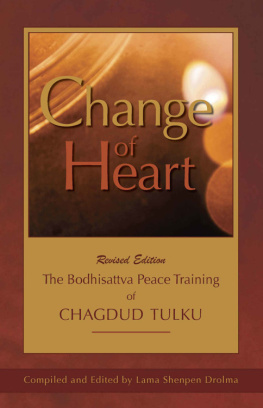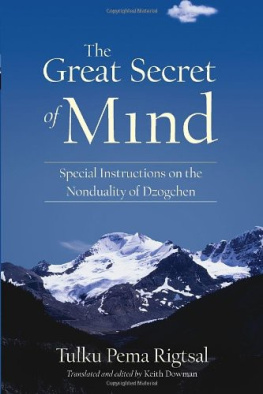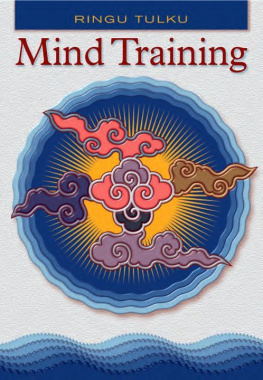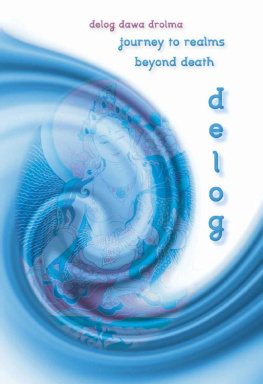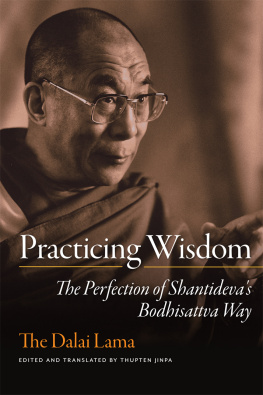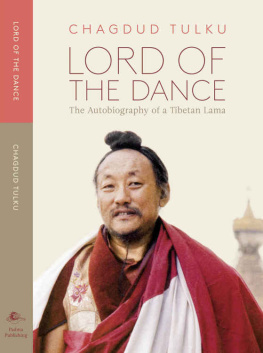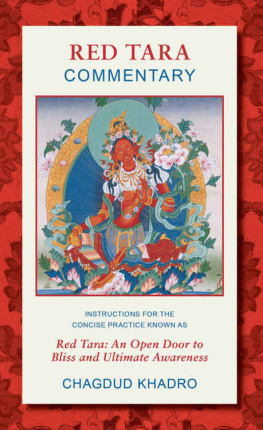Padma Publishing
P.O. Box 279, Junction City, CA 96048-0279
www.tibetantreasures.com
Padma Publishing 2003
Revised Edition 2015
eBook Edition 2015
All rights reserved. No part of this book may be reproduced in any form or by any means, electronic or mechanical, including photocopy, recording, or any information storage or retrieval system without permission in writing from the publisher.
Printed in the united states of America
Library of Congress Cataloging-in-Publication Data
Chagdud Tulku, 1930-2002
Change of heart : the Bodhisattva Peace Training of Chagdud Tulku compiled and edited by Lama Shenpen Drolma.
p. cm.
1. Religious lifeBuddhism. 2. Buddhismdoctrines.
I. Title: Bodhisattva Peace Training of Chagdud Tulku.
II. Drolma, Shenpen, Lama. III. Title
BQ5395.C42 2003
294.3444dc21
ISBN 978-1-881847-43-4 Paperback
ISBN: 978-1-881847-45-8 eBook
2002011260
CIP
Dedicated to the fulfillment of the enlightened intent of
HIS EMINENCE CHAGDUD TULKU RINPOCHE
Contents
THIS BOOK IS FOR THOSE who want to changetheir hearts, their minds, the world. It is a guide, a manual of simple, accessible, and quietly revolutionary steps that individuals can take to transform their lives and the lives of others. On whatever level the teachings presented here are appliedfrom the intimate sphere of personal experience, to the complex dynamics of family, community, national, and even international relationsthey will lead infallibly toward fulfillment and peace.
These teachings are drawn from a series of trainings conducted by His Eminence Chagdud Tulku Rinpoche, my teacher, respectfully and affectionately known simply as Rinpoche (Precious One) by all who knew him. He embodied and demonstrated the heart of the sacred dharmathe Buddhist teachingsand his realization of their inner meaning was so profound that he could convey their essence to all kinds of people, regardless of their life circumstances. I think it is safe to say that no one who met him remained untouched by his qualities of unfathomable wisdom and compassion.
Born in 1930 in eastern Tibet, Rinpoche studied with some of the greatest lamas of the twentieth century. He undertook extensive scholastic and meditative training, including two traditional three-year retreats. In 1959, during the consolidation of power by the Communist Chinese, he fled Tibet. For the next twenty years, he helped develop several Tibetan refugee communities in India and Nepal, serving the residents as lama and physician.
In 1979 he came to the United States, where he established Chagdud Gonpa Foundation, named after his monastery in eastern Tibet. Over the years, he created numerous centers for the study and practice of Vajrayana Buddhism throughout North and South America, Europe, and Australia. In 1996 Rinpoche moved to Brazil, where the vast range of his activity continued to grow. He taught tirelessly through the very evening of his passing in November 2002.
I met Rinpoche in the course of a search for spiritual tools that would help to overcome limitations of my heart and mind that had grown increasingly apparent as I attempted to respond to suffering in the world around me. My effectiveness had been gradually undermined by periodic discouragement and disappointmenta problem common to many working on behalf of others, whether on a personal or public level.
In Rinpoches transmission of the 2,500-year-old tradition of Buddhism, I was surprised and profoundly grateful to find the very practical, accessible wisdom I had been looking for, as well as methods for navigating my modern American life. As a foundation for kindness and as a preparation for helping others, the teachings were life-altering. Moved by their extraordinary effectiveness, I was also concerned that they reach those who might be uncomfortable receiving them in a Buddhist context.
In his inimitable style, in order to benefit as many beings as possible, Rinpoche created an innovative format for presenting these toolsthe essential methods of Mahayana Buddhism offered in such a way that anyone of any faith, political or philosophical persuasion could use them. And so the Bodhisattva Peace Training was born.
In the last fourteen years of his life, Rinpoche gave the Bodhisattva Peace Training to hundreds of individuals in a multitude of settings. I had the privilege of participating in a number of these trainings, both as student and as interpreter of his unique English. There are truly no words to describe the experience of sitting with him among people of all ages, backgrounds, and spiritual paths as their minds opened. Whether they were coming from places of deep rage, depression, confusion, or strong political or social ideologies, Rinpoche gently, persistently, and unfailingly showed them the loving, kind, and compassionate depths of their hearts.
In 1996 I began the process of bringing the Bodhisattva Peace Training into book form, sorting through transcripts of trainings Rinpoche had conducted with a variety of participants from diverse backgrounds. Work on the book intensified after Rinpoches visits to Iron Knot Ranch, his center in southern New Mexico, where I had served as resident lama since 1999. A number of us at the ranch had aspired for some time to fulfill Rinpoches long-held wish that these teachings become more widely available through the establishment of an institute where sincere practitioners could train and become qualified to teach the methods of the Bodhisattva Peace Training. During these visits, Rinpoche described his vision of the development of such an institute at Iron Knot Ranch and emphasized the importance of completing this book.
Finally, in the summer and fall of 2002, I went into retreat to finish the manuscript. That November, on my way to Brazil to read him the most recent draft, I received the news that he was experiencing severe chest pains. The next night he died.
So it is with deep sadness and regret that I complete this book without his feedback and corrections. I have tried to the best of my ability to preserve both the tone and content of his transmission of these teachings, and I take full responsibility for any errors or misrepresentations.
I have attempted here to convey the spirit of a Bodhisattva Peace Training with an intimate gathering of students. This necessarily involves the repetition of certain themes, which naturally takes place in such a setting. Most chapters begin with a teaching followed by questions and answers. A majority of the questions were pulled from transcripts and are articulated by eleven fictitious characters whose backgrounds and concerns mirror the array of Bodhisattva Peace Training students. Many chapters in the first two sections close with suggested formal meditation practices. Although Rinpoche taught these meditations in various ways over the years, in this book they follow a format that many participants have found helpful in trainings I have conducted since Rinpoche authorized me to give these teachings.
When we put the teachings into practice, change happens in the mind. Through our reading, questioning, and engagement, they come alive as direct personal experience. Rather than presenting spiritual truths theoretically, this book reflects Rinpoches insistence that the genuine spiritual path involves constant practice throughout ones life. When diligently applied, these methods serve as stepping-stones to an awakening of compassionan inexhaustible source of strength and resolvefrom which change can be skillfully effected, both inwardly and outwardly.

